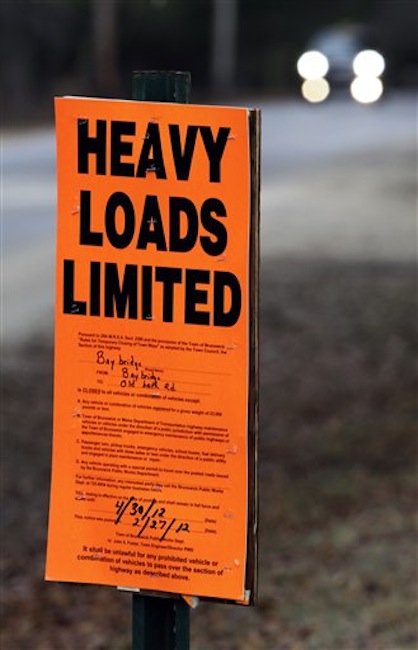PORTLAND — Heavy trucks are being temporarily banned from thousands of miles of secondary roads across northern New England with the early arrival of spring.
The mild late-winter weather has prompted officials to restrict heavy traffic on secondary roads two, three and even four weeks earlier than usual in Maine, New Hampshire and Vermont, where it’s an annual ritual to post signs on poles along roadways warning heavy trucks to stay off.
When roads are “posted” to protect them during the spring thaw, businesses have to delay heavy deliveries until the road beds dry out, lighten their loads or ask the state for exemptions for such tasks as picking up milk at dairy farms, delivering firewood or wood pellets, or picking up trash.
In the northern Maine town of Fort Kent, TNT Road Co. employees are working shifts starting at 10 p.m. to load and deliver shipments of wood chips, bark and sawdust to biomass energy plants. They have to work at night rather than their usual 4 a.m. shifts because that’s when the temperatures cool down far enough, to below 28 degrees, so they can drive on the rural paved roads and dirt logging roads to pick up and deliver their loads.
“It’s an inconvenience, it’s a hardship, it’s an adjustment on everybody, it’s less productive,” said owner Steve Theriault. “But we all know it’s for a short time, so we try to make the best of it. We certainly can’t control Mother Nature, so we try to work around her for a few weeks.”
As surely as spring brings maple syrup and mud to northern New England, it also marks the arrival of “Heavy Loads Limited” signs that are posted on poles along thousands of miles of secondary roads.
State and local officials limit truck weights on a road-by-road basis every late winter or early spring to protect certain roads from heavy trucks when frost is melting from the road base. When the frost starts coming out of the ground, the soils under roads that haven’t been properly constructed become soft, unable to support heavy vehicles.
Recent warm temperatures have made for golf courses opening early and the early arrival of ice cream trucks in family neighborhoods. They’ve also made for roads being posted much earlier than usual.
The southern Vermont town of Wilmington typically posts in mid-April depending on the snowpack and the depth of the frost. This year, the signs went up in mid-March.
“It’s been a mild winter and early spring, so we can’t really complain as far as snow melt goes, but it’s not making it easier for people driving around the back roads,” said Town Manager Scott Murphy.
In Maine, the Department of Transportation gets an earful this time of year from companies that can’t drive on some roads with heavy loads like gravel, logs or building supplies.
Officials work with them to find ways they can get around the postings — with lightened loads or driving at night when the temperatures drop and the road beds stabilize — but on occasion they have to just say no.
Roads are typically posted for four or five weeks, but that could change if the warm weather keeps up, as is forecast for the coming week, said Clifford Curtis, the Transportation Department’s assistant highway maintenance engineer.
“Hopefully it will translate into an earlier ending of the posted roads as well,” he said.
Send questions/comments to the editors.



Success. Please wait for the page to reload. If the page does not reload within 5 seconds, please refresh the page.
Enter your email and password to access comments.
Hi, to comment on stories you must . This profile is in addition to your subscription and website login.
Already have a commenting profile? .
Invalid username/password.
Please check your email to confirm and complete your registration.
Only subscribers are eligible to post comments. Please subscribe or login first for digital access. Here’s why.
Use the form below to reset your password. When you've submitted your account email, we will send an email with a reset code.